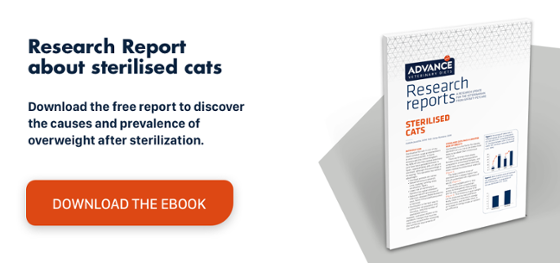Care for castrated cats: physical and nutritional care
The importance of castration in cats
Castration is the surgical technique by which the ovaries are removed either alone (ovariectomy) or with the uterus (ovariohysterectomy) to render females reproductively inactive. This procedure is carried out for a variety of reasons, including to:
- Avoid unwanted pregnancies, oestrus and phantom pregnancies.
- Reduce sexual conducts (vocalisation, marking, rubbing or running away) and improve overall behaviour.
- Decrease the likelihood of hormone-dependent diseases, such as mammary tumours.
- Reduce uterine infections, such as pyometra.
It is important to determine the best time to castrate each patient. Cats are seasonally polyoestrous animals and experience induced ovulation, so female cats do not have clearly defined oestrous cycles, with heat occurring at an interval of around 14 to 19 days.
Cats should not be castrated during oestrous, as it complicates the surgical intervention and poses an added risk to the animal. Castration should therefore be performed when the cat is in anoestrus.
In the past, it was common for the animal to be castrated after falling pregnant and giving birth at least once. Nowadays there is no need to allow such a long period of time to pass before the intervention, as it does not provide any additional benefits.
Some vets recommend castrating cats before the first oestrous, as this eliminates sexual behaviour before it begins. However, other experts stress the importance of allowing females to establish sexual maturity to ensure the animal’s complete development.
Several oral or injectable progesterone-based medications can control and inhibit the female cat’s sexual cycle. However, these drugs are not without side effects that may endanger the animal’s health.
Postoperative care for castrated cats
Once a cat has been castrated, a series of care techniques should be employed for its speedy and optimal recovery. These practices can be classified into three main groups:
- Surgical wound care: it is important to avoid disturbing or damaging the surgical incision, so the cat must be prevented from reaching the wound, trying to lick and scratch it or remove the stitches. This can be done by using abdominal wound dressings, T-shirts or bodies to act as a corset and protect the wound by preventing access. Another option is an Elizabethan collar, but this may lead to other complications such as stress or depression. The owner must clean the wound with disinfectant products at least three times a day.
- Management techniques: while the surgical wound is healing, the patient should not realise any abrupt movements or significant physical activity to avoid disrupting the stitches which might complicate the cat’s recovery. During the recovery period, the vet should prescribe analgesics and antibiotics specific to each case.
- Nutritional care: after castration, female cats are prone to weight gain due to the hormonal change. After the intervention, a commercially available energy-restricted diet should be introduced, their daily consumption monitored and the animal’s physical activity increased. It is important to control the cat’s weight gain and body condition after the operation.
Conclusions
Postoperative care for castrated cats is just as important as the intervention itself; management guidelines need to be established in relation to nutrition, the animal’s activity and techniques to protect the surgical wound.

